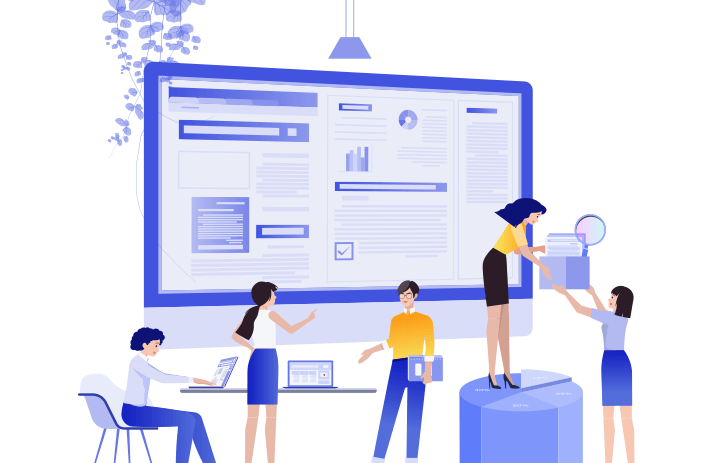
Click the button to start reading
Telework or Remote Work? Explaining the differences and what’s best for your team.
What’s the difference between telework and remote work?
Until recently, “remote work” sounded like something digital nomads did. Picture someone working poolside or with a beach in the background, from a coworking space in Bali or an apartment in Amsterdam. Free from the dreaded cubicle, it made most of us ask – “So, do you ever actually work?”.
“Telework,” on the other hand, sounded a bit more dated. While the term refers to being able to use the internet to work outside of a central office, it hardly inspires the same idea of an exotic vacation.
But with the pandemic came a drastic cultural shift in how people thought about the conventional office. Rather than a commute-free life being something to aspire to, people of all professional levels and backgrounds experienced working outside of an office as a reality. They built their home office setups and exited cities in unprecedented numbers. Companies upgraded their capacity for offsite work, and many downsized or closed their headquarters entirely.
What was left is a complete change in how people think about when, where, and how they worked. Remote work or telework became the predominant way of operating rather than just being a slight trend.
Wondering about the differences between telework and remote work? How about which model will work better for your business? Here’s our quick-and-easy explainer of remote work vs. telework.

What’s the difference between telework vs. remote work?
You might have heard the two work concepts – telework and remote work – used interchangeably. And while the basic ideas may be similar, they’re not the same. Here’s a look at where remote work and telework differ.
Remote work
By definition, remote work is “a work arrangement in which employees do not commute or travel to a central place of work such as an office building, warehouse, or store.” This means that remote workers can work from anywhere they choose. Their official place of work is not the central office but rather their own provided workspace.
While the exact terms depend on the agreement the employee has with the employer, remote work tends to be more flexible in time zone or geography. There might be no central office; even if there is, a remote employee isn’t usually expected to be onsite (except for perhaps a couple of times a year). Remote workers also might be free to work asynchronously, meaning they can set their hours or collaborate without necessarily being online at the same time as their team.
Telework
Conversely, telework means “the action or practice of working from home, making use of the internet, email, and the telephone.” Generally speaking, telework provides additional flexibility – an employee has approval to work from a second location – yet their official place of work is still the central office.
A telework arrangement typically requires some onsite presence, meaning the teleworker must live in the same time zone or geographic region as the rest of the company. A telework agreement most often implies a regular and recurring in-person engagement, whether for important meetings or if it’s a normal part of the job. Most often, telework is synchronous, meaning the employee must be online at the same hours as their team.

Telework or remote work – which is better for my business?
We’ve written a lot about remote work and hybrid work at Teamly. If you decide this is something you’d like to implement in your own company, there are some steps you can take to make the transition as impactful as possible.
1. Understand your Goals. What’s your reason for introducing telework or remote work for your team? Based on that, you can choose a model that works best for you. Some common reasons you might want to try one of these flexible models are to cut back on overhead costs (office space, employee lunches, commuter benefits), improve employee satisfaction, increase productivity, or recruit better candidates. Once you’re clear on your high-level goal, get specific – what KPIs can you use to determine if this new model is effective? How and when will you measure it and make adjustments?
2. Choose a Model. Once you’re clear on your goals, you can choose the work schedule that best aligns with your team. Do you prefer telework, remote work, or something hybrid? Include employees and managers in this decision. What kind of work schedule would they choose? What people or departments need to be together at the same time? Is this policy available to all employees or just specific roles and departments?
When you’ve chosen a model, learn as much about it as possible – what other companies have used it? What new tools will you need to support it? If it’s a significant change for employees, what benefits might you add to improve their work environment? Look for a schedule template that you can use. Create documentation outlining the policy for managers and employees so expectations are clear.
3. Choose Tools & Documentation. Once you’ve landed on a model, the next step is to choose the tools and documentation that will support your transition. Some of the tools you might consider for your team are…
- Employee scheduling or booking tools. When are team members onsite vs. remote? And if fewer desks or resources are available, how will you manage bookings for desks, meeting rooms, etc., on the days they come in?
- Remote project management tools. Going hybrid is a great time to invest in project management tools. Tools like Asana, Trello, or Teamly all have robust features that allow remote teams to stay on track toward their goals, complete tasks, and collaborate.
- Communication tools. Communication tools might be chat or video conferencing, enabling employees to stay in touch when not in person.
In addition to tools, consider adding documentation or digital resources to help your team transition to your new work model.
4. Start with a Trial Group. The next step is communicating an upcoming change to the team and choosing a small trial group to pilot the new work model. This might be a department or a team. The trial should be for a limited period with your KPIs in mind – and once it’s done, you should have a clearer idea of how the model will work if rolled out further in your organization.
Get feedback from the trial group and adjust as needed to support your organizational goals.
5. Roll out hybrid work policy to the extended team. You’ve outlined your goals, set up the necessary tools, and experimented with a trial group. Now, it’s time for the hard work to pay off! The transition period will require some adjustment – especially if it’s company-wide – so keep this in mind and stay flexible.

FAQs: Telework vs Remote Work
Which one is better – telework or remote work?
You might wonder which is better when you put telework vs. remote work. From an employee perspective, it depends on your unique needs. Digital nomads or people who are more location-independent might prefer remote work as it allows them to work from anywhere. They can find employment in one city while traveling or staying long-term in others.
On the other hand, telework can be an excellent option for people who are more location-dependent but who value or require some extra flexibility in their day. This is likely true for people with significant commitments outside of work, people living far from the office, people who work better from home, etc. Telework enables them greater autonomy and flexibility – no daily commute! – while still giving them access to the office when needed.
For employees – what are the benefits of telework or remote work?
Working from home can seem like a dream from an employee perspective. Imagine getting back all the time you used to spend commuting, working from anywhere, etc. There are many benefits to telework or remote work for employees, but some of the big ones are…
- Flexibility – with greater control over their time, teleworkers or remote workers enjoy greater freedom and flexibility than they would have before.
- Cost saving – the costs of working can add up. Everything from commuting costs to office-appropriate clothing to the cost of lunch with coworkers can potentially go down with an offsite work model.
- Save time – along with freedom and flexibility, employees can often save lots of time not commuting into the office every day
- Location – another significant benefit for employees is more flexibility to choose where they live. Without worrying about a daily commute, they might choose something that better fits their needs and adjust when it’s required that they’re onsite.
- Focus – for some employees, an office can be a distraction. Telework or remote work can empower some people to focus better and be more productive than in the office.
- Work/life balance – Some employees find that a flexible work schedule has improved their work/life balance. They might pop to the gym during lunch or use the morning to drop their kids at school before logging on for the day.
For employees – what are the challenges of telework or remote work?
Of course, remote or telework isn’t the right fit for everyone. Here are some of the common pitfalls or challenges from an employee perspective.
- Time Management – many employees struggle to manage their time without the accountability that an office or on-site manager provides
- Collaboration and communication – while many tools can support collaboration and communication, the lack of in-person communication can create more challenges.
- Productivity and organization – studies show that employees are generally more productive when working offsite, but that’s not true for everyone. Some employees might experience challenges in productivity and organization when they’re out of the office.
- Asynchronous work – another big challenge can be working asynchronously – across time zones or cultures. While your company might have systems to ease the burden, asynchronous work introduces unforeseen challenges.
- Technical problems – technology has eased so many of our problems! But it can also create new ones. Faulty internet connections, unsaved updates, or other technical issues can be a more significant issue when working offsite.
- Engagement – keeping employees engaged and connected can be a major struggle with remote or telework.
- Work/life balance – on the other side of the coin, some employees find their work/life balance deteriorates when they don’t have to go into the office. They might have a harder time separating their physical living space, knowing when to sign off, or work extra time to prove themselves if managers are not seeing them on a day-to-day basis
- Distractions – for some, working from home can be more distracting than working from the office ever was. Kids, pets, and other responsibilities easily avoided with a trip to the office become front-and-center when working from home.
For employers – what are the benefits of telework or remote work?
Over the years, there has been a gradual trend towards telework or remote work. But, during the pandemic, companies were pressured to determine the most effective ways to manage their teams. Some of the most significant benefits of telework or remote work for employers are…
- Cost savings – maintaining an office space can be huge for companies. By downsizing or closing down unused offices, companies could invest that money into employees or company initiatives.
- Expanded talent pool – with fewer geographical limits, employers are better able to choose from a more diverse or qualified talent pool
- Productivity – productivity trended upward at the start of the pandemic. And the data still shows that fewer meetings and distractions make employees more productive when not working in the office.
- Employee retention – with greater flexibility comes happier employees. Ones who are less likely to quit or switch jobs.
- Adaptability and future-proofing – while the pandemic accelerated the trend towards remote or telework, companies have been trending towards more location-independent options for years. Companies pushed to adapt their technology, processes, culture, etc., are better insulated from future challenges.
For employers – what are the challenges of telework or remote work?
Of course, remote work and telework aren’t without challenges for employers. Some of the biggest ones are…
- Engagement and culture – without an office, it can be much harder for companies to welcome employees into their culture or keep them engaged. Here are some tips on how to manage this.
- Hiring, training, and management – as the way your company works changes, you’ll need to update your hiring, training, and management practices to fit. Your organization will need more autonomous teams, which can require changes at all levels.
- Loss of control – offsite work requires higher trust and surrender of control. As you won’t see employees working, you’ll have to have faith in your people, your managers, and your processes to stay on track.
- Security risks – new security risks come into play when your employees aren’t working from the office. Whether it’s an insecure Wi-Fi network or a lost laptop, you might want to invest in additional security measures to protect your company in this transition.

Which jobs can you do remotely or with telework?
Opportunities for remote work and telework used to be more limited. But these days, many jobs are well suited for remote or telework! Some of the best jobs for remote work require digital skills – software developers, web developers, graphic designers, marketers, accountants, etc. People specialized in these skills will generally have an easier time finding work.
However, many non-tech jobs have transitioned to allow for flexible work. Telehealth means that therapy and doctor appointments can be handled remotely. Changing consumer preferences means that everyone can make a good living online, from yoga instructors to interior designers to teachers.
Jobs unsuited for telework are typically more bureaucratic, heavily regulated, or dependent on face-to-face engagement or administration. For example, public school teachers, hospital workers, carpenters, hospitality workers, etc. will likely need to report to a physical workplace to do their job.
















